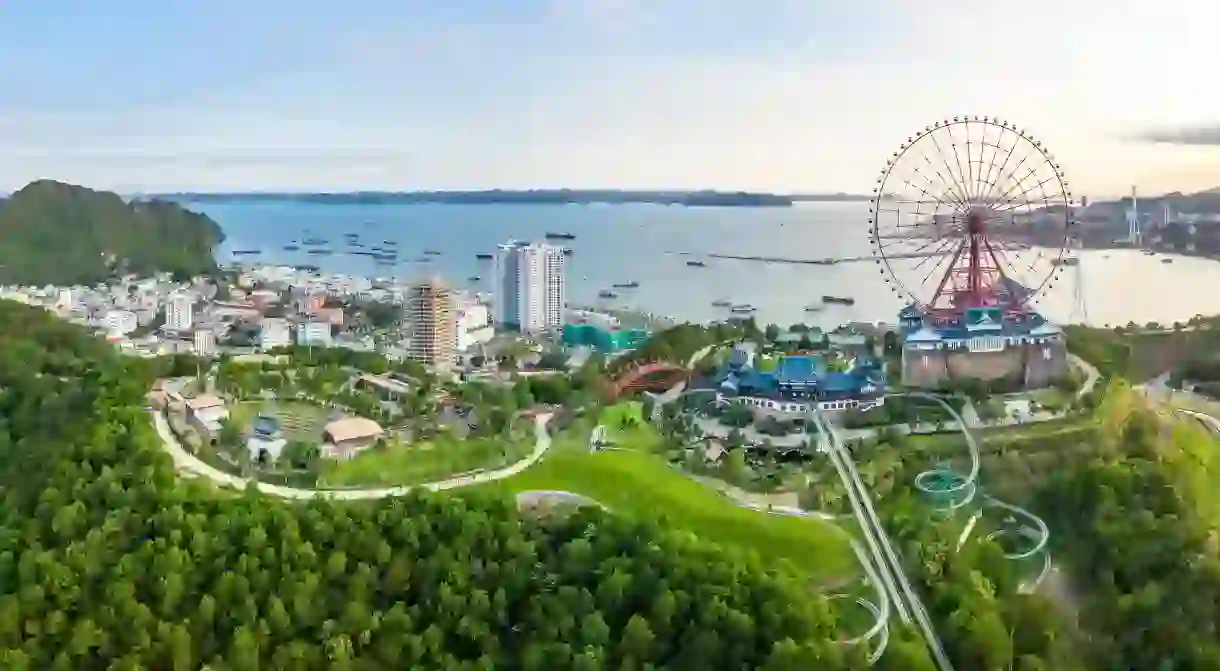The Best Things to See and Do in Ha Long Bay, Vietnam

Its name translates as the “Bay of Descending Dragons” and it’s not hard to understand why Ha Long Bay has such mythic appeal. The most visited tourist attraction in Vietnam blends spellbindingly beautiful coastline with an emerald sea that ripples with limestone monoliths by the thousand. Throw in spooky stalactite-spiked caves, picturesque islands and miraculously built floating fishing villages and you have a veritable bucket list destination. How to see the best of Ha Long Bay, Vietnam? Start here – and get planning!
See Ha Long city
Architectural Landmark

Most visitors to Ha Long Bay whizz in from Hanoi without a glance at nearby Ha Long city. Yet it’s an attractive base for bay trips – built around dramatic jungle-covered limestone hills and fronted by a white sand beach. There are astonishing bay views from the Queen cable car – which runs over the ocean to the jagged Ba Deo peak. And while Hanoi is a three-hour drive from Ha Long Bay, Ha Long city is a mere 25 minutes away.
Visit the beach
Natural Feature

Ignore the detractors who claim that there are no beaches in Ha Long Bay. There are – and they just so happen to be some of the most beautiful in North Vietnam. Long crescents of sand fringe Quan Lan and Tuan Chau islands, near Ha Long city. Tuan Chau’s main sprawl is a dream – a 3km (2mi) stretch nuzzled by turquoise ocean shallows. Roll up and you’ve got the perfect spot to spread a shawl, sip a few Mai Tais and contemplate that gorgeous view of myriad pinnacle islands.
Discover grottoes
Natural Feature

Ha Long’s pinnacle islands are cut with caves. Most cruise visits include a gentle row through the arches of Luon cave and a clamber into the garishly lit, stalactite-filled Sung Sot cave, one of the largest in the bay. Trinh Nu, on Bo Hon Island, and Thien Kung (aka Paradise Cave) receive fewer visitors. The former drips with flowstones that look like statues of women with hair falling over their eyes, the latter is dramatically pierced by a single shaft of light. If you thought caving was for anoraks, open your eyes.
Tour the floating villages
Architectural Landmark

Fishermen have been living in Ha Long Bay for millennia, mostly on self-constructed floating islands that dot the emerald sea between Ha Long’s jungle-swathed peaks. The prettiest is Cua Van floating village; keep your eyes peeled for its brightly-painted huts and fishing boats veiled with drying nets. Tours and self-guided kayak trips around the village and fish farm are easy to organise with tour operators in Ha Long or Hanoi.
Day-trip to Cat Ba Island
Natural Feature

Ha Long Bay’s largest island is covered in pristine rainforest, pocked with caves and home to one of Asia’s rarest mammals, the critically endangered white-headed langur monkey. It’s also a great place to embark on a hike into pristine rainforest culminating in breathtaking bay and island views. The island’s south is sculpted with half-moon coves of coral sand where there are idyllic little places to stay. Consider a few days.
Kayak and scuba-dive
Natural Feature

Kayaking around Ha Long’s smaller peaks, through arches and caves, over glassily clear water, is magical. Most of the bay is off-limits, but it’s possible to paddle around the floating villages, through Luon cave and around the craggy islands at Cong Do, which are dotted with hidden lagoons and edged with beaches and coral gardens. The deeper reefs in Cong Do’s southwest are among the bay’s best snorkelling and diving spots.
Glimpse Ha Long Bay from a seaplane
Natural Feature

The best way to arrive from Hanoi? By seaplane of course. The Vietnamese will tell you that Ha Long was formed when dragons spat gems into the South China Sea to create a fortress against armies from the north. From the air, it’s easy to imagine they’re right as you gawp at the more than 2,000 jade-green, forested islets encircled by silvery beaches and beyond them, open emerald seas.
Go scuba diving in Lan Ha Bay
Natural Feature

Where Ha Long Bay meets the open ocean it reveals clusters of larger islands, ringed with reefs that fall away abruptly into deeper sea. While much of the coral in Ha Long Bay has died, there are still a few living reefs in Lan Ha, especially around the islands of Cong Do and Vung Ha. The water is warmest between May and November and resorts in both destinations can organise dives. You can visit Lan Ha Bay on a luxury overnight cruise as part of Culture Trip’s specially curated 12-day Vietnam adventure, led by our Local Insider.
Learn Vietnamese-cooking skills
Building, School, Architectural Landmark
Cooking schools are two a penny in urban Vietnam, but there are precious few places where you can perfect your pho soups and green papaya salads with a beautiful bucolic view on the doorstep. Ginger Cookery, in Ha Long city, was founded by a local who made her name in restaurants in Hanoi. With classes lasting just a few hours and accommodation available in luxe wooden garden bungalows, it’s easy to squeeze a session in before your bay cruise.













